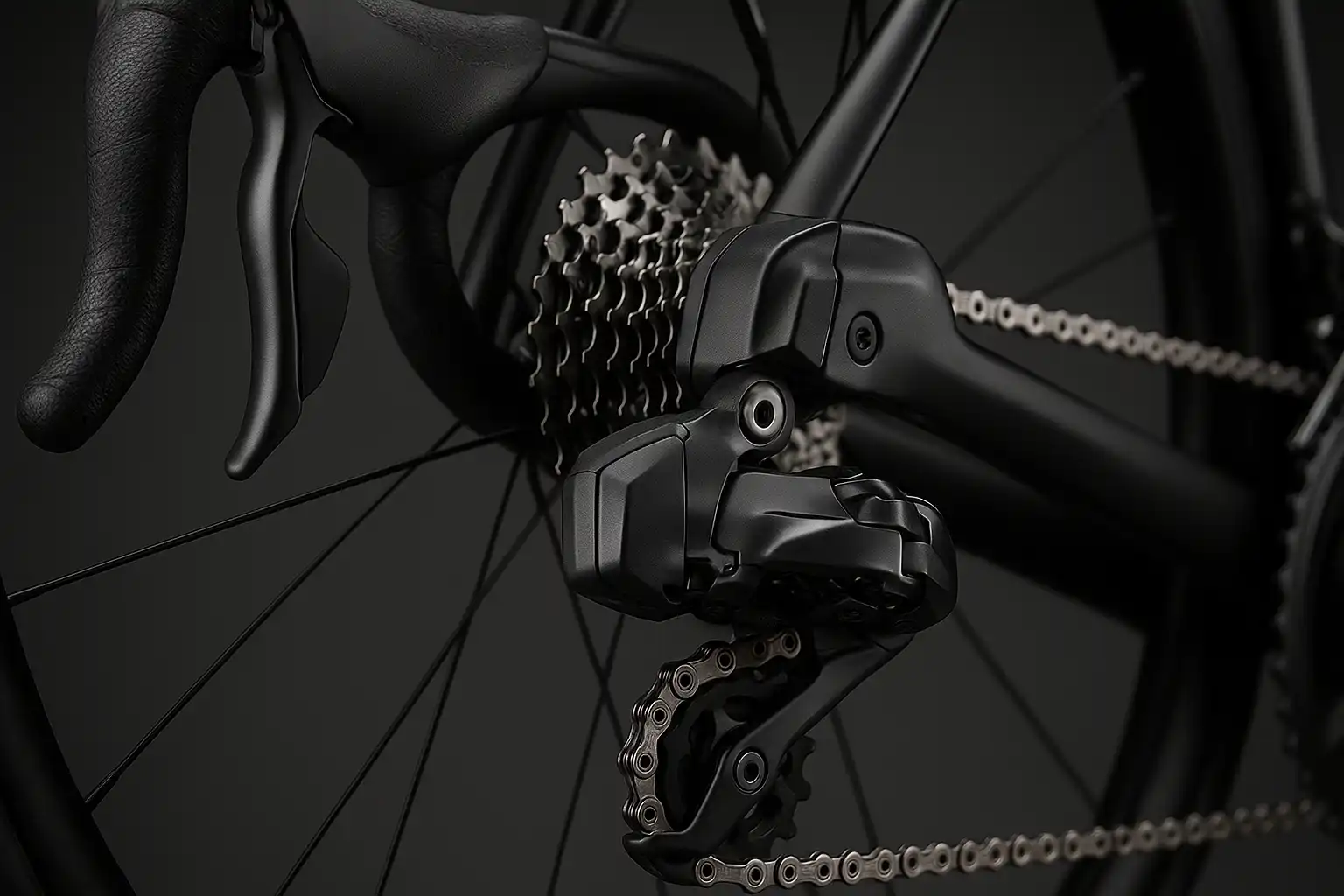Advanced cycling technology in 2025 represents the culmination of decades of innovation, engineering excellence, and the relentless pursuit of performance optimization. From wireless electronic shifting systems that respond instantly to rider input to sophisticated aerodynamic designs that slice through the air with minimal resistance, modern cycling technology is pushing the boundaries of what’s possible on two wheels.
The integration of digital technology, advanced materials, and precision engineering has created bicycles and components that would have been unimaginable just a few years ago. These technological advances aren’t just about going faster—they’re about creating more reliable, more efficient, and more enjoyable cycling experiences for riders of all levels.
## Wireless Shifting: The End of Cables
Wireless electronic shifting has reached maturity in 2025, with systems that offer instantaneous, precise gear changes without the complexity and maintenance requirements of traditional cable systems. The elimination of cables has simplified bike design while improving performance and reliability.
Battery technology in wireless shifting systems has advanced significantly, with many systems offering 1000+ hours of operation on a single charge. Improved power management and more efficient electronics have made battery life a non-issue for most riders.
Shift quality and speed have improved dramatically, with modern wireless systems providing faster, more precise shifts than any mechanical system. The electronic control allows for optimized shift timing and force that adapts to riding conditions and rider preferences.
Customization options in wireless shifting systems allow riders to personalize shift behavior, button mapping, and system responses. Smartphone apps provide easy access to system settings and enable firmware updates that add new features and improvements.
Integration with other bike systems is seamless with wireless shifting, as the absence of cables eliminates routing conflicts and allows for cleaner integration with other electronic components like power meters and bike computers.
Reliability improvements in wireless shifting include redundant communication protocols, automatic system diagnostics, and fail-safe modes that ensure continued operation even if individual components fail.
## Smart Bike Computers: Intelligence on the Handlebars
Bike computers have evolved into sophisticated computing platforms that provide navigation, performance analysis, safety features, and connectivity that rivals smartphone capabilities. Modern bike computers are essential tools for serious cyclists and valuable accessories for recreational riders.
GPS accuracy and mapping capabilities have improved dramatically, with multi-band GNSS receivers providing precise positioning even in challenging environments like urban canyons or dense forests. Detailed mapping and turn-by-turn navigation make bike computers valuable tools for exploration and commuting.
Performance metrics tracking includes power, heart rate, cadence, speed, and advanced analytics that provide insights into training effectiveness and performance trends. Real-time coaching features can provide guidance during workouts and suggest training adjustments based on current performance.
Safety features in smart bike computers include incident detection, emergency communication, and integration with radar and lighting systems. These features provide peace of mind and can be crucial in emergency situations.
Connectivity options include WiFi, Bluetooth, and cellular capabilities that enable real-time data sharing, live tracking, and communication with other devices and platforms. This connectivity creates comprehensive cycling ecosystems that enhance the riding experience.
Battery life in modern bike computers has improved significantly, with many devices offering 20+ hours of operation with GPS and all features active. Solar charging capabilities in some models provide virtually unlimited battery life for long-distance adventures.
## Aerodynamic Innovation: Cutting Through the Air
Aerodynamic technology has advanced significantly, with computational fluid dynamics, wind tunnel testing, and real-world validation creating bikes and components that minimize drag while maintaining practical functionality.
Frame aerodynamics have been optimized through extensive testing and simulation, with tube shapes, junction designs, and component integration all contributing to reduced drag. Modern aero bikes can save significant watts compared to traditional designs while maintaining comfort and handling characteristics.
Wheel aerodynamics continue to evolve, with new rim profiles, spoke designs, and tire integration creating wheels that perform well in a wide range of conditions. The integration of aerodynamic and lightweight design has created wheels that excel in both climbing and flat terrain.
Component integration plays a crucial role in overall aerodynamic performance, with cables, brakes, and accessories designed to work together as complete aerodynamic systems. This integrated approach provides better performance than individual aerodynamic components used in isolation.
Real-world aerodynamics testing has become more sophisticated, with on-road testing protocols that validate wind tunnel results in actual riding conditions. This testing ensures that aerodynamic improvements translate to real-world performance benefits.
Rider position optimization is increasingly important in aerodynamic performance, with bike fitting technology and position analysis helping riders achieve optimal aerodynamic positions while maintaining comfort and power output.
## Material Science: Stronger, Lighter, Better
Advanced materials are enabling new possibilities in bicycle design, with carbon fiber, titanium, and exotic alloys providing strength, weight, and performance characteristics that were previously impossible to achieve.
Carbon fiber technology has advanced significantly, with new fiber types, resin systems, and manufacturing processes creating frames that are lighter, stronger, and more durable than ever before. Automated manufacturing processes are improving consistency while reducing costs.
Titanium applications in cycling have expanded beyond frames to include components like handlebars, seat posts, and hardware. Advanced titanium alloys provide excellent strength-to-weight ratios and corrosion resistance while offering unique ride characteristics.
Steel innovations include new alloy compositions and manufacturing techniques that create steel frames with improved performance characteristics. Modern steel frames can be surprisingly light while offering the durability and ride quality that steel is known for.
Composite materials beyond carbon fiber are being explored for cycling applications, including natural fiber composites and hybrid materials that combine different fiber types for optimized performance characteristics.
Manufacturing innovations like 3D printing and automated fiber placement are enabling new design possibilities and customization options that were previously impossible or prohibitively expensive.
## Power Measurement: Precision Performance Data
Power measurement technology has become more accurate, affordable, and accessible, with power meters now available for virtually every type of bicycle and riding style. This technology provides the most objective measure of cycling performance and enables precise training and pacing strategies.
Accuracy improvements in power meters have made them reliable tools for performance measurement and training. Modern power meters typically provide accuracy within 1-2%, making them suitable for serious training and competition use.
Installation and compatibility have improved significantly, with power meters available for different crank systems, pedals, and hubs. This variety allows riders to choose power measurement solutions that work with their existing equipment and preferences.
Data analysis capabilities have expanded beyond simple power measurement to include advanced metrics like left/right balance, pedaling smoothness, and torque effectiveness. These metrics provide insights into pedaling technique and efficiency that can guide training and bike fitting decisions.
Battery life and maintenance requirements have improved in modern power meters, with many systems offering hundreds of hours of operation and minimal maintenance requirements. This reliability makes power meters practical for daily training and long-distance events.
Integration with training platforms and analysis software provides comprehensive power-based training capabilities. Real-time power data can guide workout execution while historical data enables long-term training analysis and planning.
## Electronic Integration: The Connected Bicycle
Modern bicycles are becoming increasingly connected, with electronic systems that communicate with each other and with external devices to provide comprehensive performance monitoring and control capabilities.
System integration allows different electronic components to share data and coordinate functions. For example, shifting systems can communicate with power meters to optimize shift timing, while bike computers can control lighting and safety systems based on riding conditions.
Smartphone connectivity enables riders to access system settings, receive notifications, and share data with training platforms and social networks. This connectivity creates seamless integration between cycling technology and digital lifestyles.
Firmware updates and feature additions can be delivered wirelessly to electronic cycling components, ensuring that systems remain current and can receive new features and improvements over time.
Diagnostic capabilities in electronic systems can identify potential issues before they become problems, alerting riders to maintenance needs and system status. This proactive approach to maintenance can prevent failures and extend component life.
Customization options allow riders to personalize system behavior and preferences through smartphone apps and computer interfaces. This customization ensures that technology adapts to individual rider preferences rather than forcing riders to adapt to technology.




